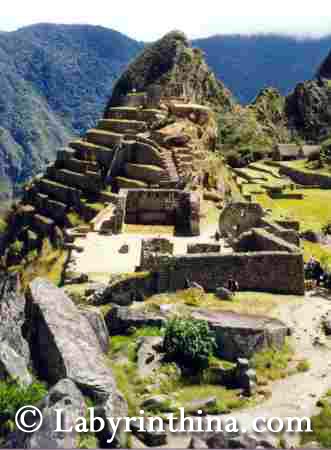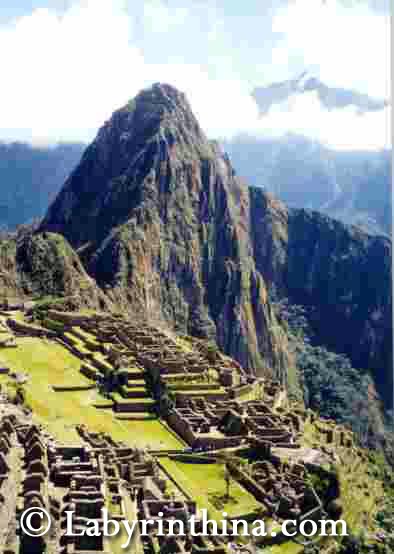|

Machu Picchu...Lost
City of the Incas
Extracts from "The Lost City of the Incas" by
Hiram Bingham
© Labyrinthina.com


It's remarkable that
Machu Picchu was first brought to the attention of the world in
1911. The Spanish invaders at the time of the Conquest and
during certuries of colonial rule, never discovered the city,
and nobody ever led them there, suggesting that the site had
long since been abondoned and forgotten.
In the nineteenth century explorers like Eugenie de Sartiges,
George Ephraim Squire, Antonio Raimondi and Castelnau never
reached Machu Picchu, although most of them crossed the Andes to
the almost inaccessible ruins of Choquekirao, built high above
the Apurimac river. In fact, the outside world simply stumbled
upon Machu Picchu, for it had never been lost to those who lived
around it. Those same people eventually led the American
explorer, Hiram Bingham, and his team to the site in 1911. Hiram
Bingham, now world-famous as the discoverer of Machu Picchu, did
not initially travel to South America to explore the land of the
Incas. In fact, the Hawaiian-born Yale and Harvard educated
historian first journeyed south from the United States to
complete his study of the great nineteenth century liberator,
Simon Bolivar.
In December 1908, Bingham attended the First Panamerican
Scientific Congress in Santiago, Chile. It was there that he
decided to follow the old Spanish trade route from Buenos Aires
to
Lima, and it was to that end that he traveled to Lima and
hence to Cusco.
In Cusco Bingham made the acquaintance of one J.J. Nunez, then
prefect of the Apurimac region, who invited him on the arduous
trip to the ruins of Choquekirao, thought at the time to be the
site of Vilcabamba, the much sought "last resting place of the
Incas."
On his return to the USA, Bingham decided to organize another
expedition to
Peru. He arrived in Lima in June 1911 where he
began to study the seventeenth-century chronicles of Antonio de
la Calancha and Fernando de Montesinos. The writings of these
two men first inspired Bingham to seek the last two capitals of
the Inca, Vilcabamba and Vitcos. Leaving Lima in July, Bingham
returned to Cusco from where he journeyed on foot and by mule
through the Urubamba Valley, past
Ollantaytambo, and on into the
Urubamba gorge.
On July 23, Bingham and his party camped by the river at a place
called Mandor Pampa, where they aroused the curiosity of Melchor
Arteaga, a local farmer who leased the land there. Through
Sergeant Carrasco, the policeman who was his guide and
interpreter, Bingham learned from Arteaga that there were
extensive ruins on top of the ridge opposite the camp, which
Arteaga, in his native Quechua, called Machu Picchu, or "old
mountain".
According to Bingham, "The morning of July 24th dawned in a cold
drizzle. Arteaga shivered and seemed inclined to stay in his
hut. I offered to pay him well if he showed me the ruins. He
demurred and said it was too hard a climb for such a wet day.
But when he found I was willing to pay him a sol, three or four
times the ordinary daily wage, he finally agreed to go. When
asked just where the ruins were, he pointed straight up to the
top of the mountain. No one supposed that they would be
particularly interesting, and no one cared to go with me."
Accompanied only by Seargeant Carrasco and Arteaga, Bingham left
the camp around 10 am. After a short while the party crossed a
bridge so unnerving that the intrepid explorer was reduced to
crawling across it on his hands and knees. From the river they
climbed a precipitous slope until they reached the ridge at
around midday.
Here Bingham rested at a small hut where they enjoyed the
hospitality of a group of campesinos. They told him that they
had been living there for about four years and explained that
they had found an extensive system of terraces on whose fertile
soil they had decided to grow their crops. Bingham was then told
that the ruins he sought were close by and he was given a guide,
the 11-year old Pablito Alvarez, to lead him there.
Almost immediately, he was greeted by the sight of a broad sweep
of ancient terraces. They numbered more than a hundred and had
recently been cleared of forest and reactivated. Led by the boy,
he re-entered the forest beyond the terraces. Here young Pablito
began to reveal to Bingham a series of white granite walls which
the historian immediately judged to be the finest examples of
masonry that he had ever seen. They were in fact, the remains of
what we call today the Royal Tomb, the Main Temple, and the
Temple of the Three Windows.

As evidenced by his writings, Hiram Bingham was genuinely
inspired by the beauty of the region he was exploring.
According to Bingham, "I had entered the marvellous canyon of
the Urubamba below the Inca fortress. Here the river escapes
from the cold plateau by tearing its way through gigantic
mountains of granite. The road runs through a land of matchless
charm. It has the majestic grandeur of the Canadian Rockies, as
well as the startling beauty of the Nuuanu Pali near Honolulu,
and the enchanting vistas of the Koolau Ditch Trail on Maui, in
my native land. In the variety of its charms the power of its
spell, I know of no place in the world which can compare with
it. Not only had it great snow peaks looming above the clouds
more than two miles overhead; gigantic precipices of many-coloured
granite rising sheer for thousands of feet above the foaming,
glistening, roaring rapids, it has also, in striking contrast,
orchids and tree ferns, the delectable beauty of luxurious
vegetation and the mysterious witchery of the jungle. One is
drawn irrisistibly onwards by ever-recurring surprises through a
deep, winding gorge, turing and twistng past overhanging cliffs
of incredible height
Above all, there is the fascination of finding here and there
under swaying vines, or perched on top of a beetling crag, the
rugged masonry of a bygone race; and of trying to understand the
bewildering romance of the ancient builders who, ages ago,
sought refuge in a region which appears to have been expressly
designed by nature as a sanctuary for the oppressed, a place
where they might fearlessly and patiently give expression to
their passion for walls of enduring beauty."
Other people saw and even lived at
Machu Picchu before Hiram
Bingham even set foot in Peru, but had neither the means nor the
opportunity to bring the "lost city" to the attention of the
outside world. Bingham himself found two families living at the
ruins and was led to the main plaza by a young boy. As early as
1894, a local farmer called Agustin Lizarraga led one Luis Bejar
Ugarte to the ancient city. This same Lizarraga took his friends
Gabino Sanchez and Enrique Palma on a treasure-seeking trip to
the ruins on July 14, 1901, visiting all the accessible parts of
the then uncleared site. When Bingham arrived at the ruins he
found the rock that the three friends had signed with their
names and the date of their visit. In his later writings,
however, he downplayed this discovery.
The three treasure hunters met Anacleto Alvarez (whom Bingham
later encountered) who told them that he had been living among
the ruins for 8 years, where he grew his crops of corn, yucca,
sweet potatos and sugar cane on the fertile soil that the Incas
had carried up from the river valley to build Machu Picchu's
magnificent 300 meter high series of terraces!
|
